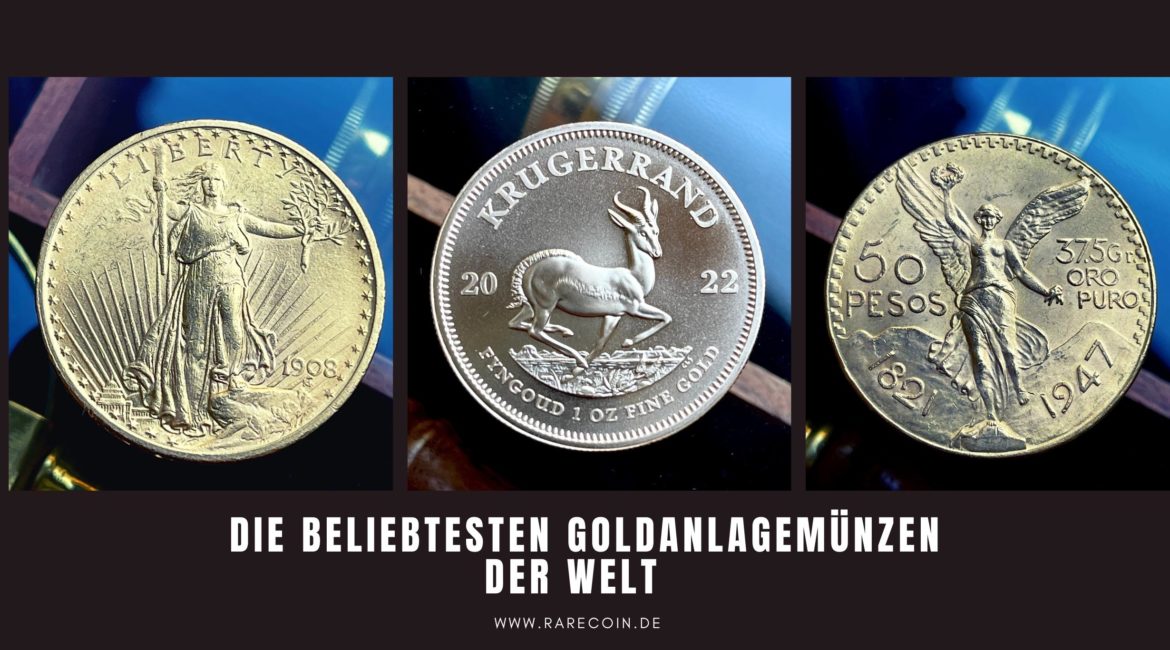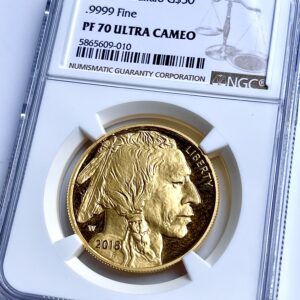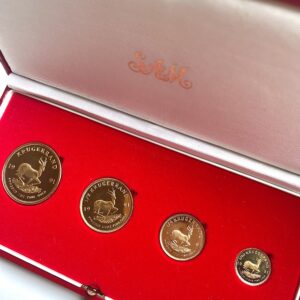Gold has been a sought-after precious metal for thousands of years. Today, gold coins are at the top of the wish list of almost all gold coin investors and gold coin collectors. While there are many popular gold coins, some are regularly the most sought after in the world. Our top gold coins are listed below.
South African Krugerrand
Introduced in 1967, the Krugerrand was the first gold bullion coin of the modern era and quickly became the best-selling coin in the world. Until 1980, the Krugerrand accounted for the majority of gold coins sold on the international market.
But the happiness of the Krugerrand was soon over. Growing concerns about the system of racial segregation in South Africa, known as apartheid, led to an embargo on trade with the African country. This has severely damaged the popularity of the South African Krugerrand at times.
The South African Mint (SA Mint) refinery still produces Krugerrands. However, its market share has declined somewhat. This is mainly due to the emergence of many other popular gold coins. Nevertheless, the outstanding value and popularity of the Krugerrand remains. This legendary gold bullion coin is a valuable addition to a precious metals portfolio. From 1967 to 1980, the Krugerrand was only available as a 1 ounce coin.
Since 1980, there are additionally the denominations ½ ounce, ¼ ounce and 1/10 ounce, besides some special sizes.
American Eagle
First issued in 1986, the American Eagle series continues to be popular with investors. The two main reasons are the high purity of the contained gold and the relatively low price compared to the spot price.
The then U.S. President R. Reagan signed a law on minting in 1985. The first American Eagle gold coins were introduced the following year. Today, these coins are popular with both collectors and investors in the United States and around the world.
The design for the front was created by the artist Augustus Saint-Gaudens. It was used on the $20 Double Eagle gold coin of 1907. The image of the Statue of Liberty on the front remained until 1933. Then in 1986, the design was adapted for use on American Eagle gold coins. Since then, it has remained unchanged.
The reverse of all American Eagle gold coins features a family of eagles around a nest. This design, created by Miley Busick, was first introduced in 1986.
Dimensions and denominations
While the silver Eagle series is offered in only one size (1 oz./one ounce weight and one dollar face value), the gold versions are available in four sizes and face values. They include:
1/10 ounce, $5
1/4 ounce, $10
1/2 ounce, $25
1 ounce, $50
Nominal value and formats
The face value indicated on the coins does not necessarily correspond to the value of the gold they contain. Theoretically, American Eagle gold coins could be issued as legal tender for something equal to their face value. But this is not recommended in any case, because in this case you will suffer a great financial loss!
Since the first American Gold Eagles were issued, they have come in four formats:
Bullion,
Burnished,
Proof and
Reverse Proof.
Bullion is the synonym for investment coins.
Proof is considered the highest minting quality for coins. In Germany, this minting quality is also known as Polished Plate and abbreviated as“PP“.
In the “Reverse Proof” variant, the motif is mirror polished and the background is matte.
Numismatists use the term “burnished” to describe the unique surface of the coins. Burnished coins appear dull and less shiny compared to a normal bullion coin. This is the result of polishing the blanks before they are stamped. Some collectors believe that the bluing increases the longevity of the design.
Most often, collectors buy American Gold Eagles in the $5 denomination of a 10th of an ounce, which is by far the cheapest of the four denominations.
Many collectors tend to buy the “burnished”, proof and reverse proof versions, although quite a number of numismatists actively collect bullion coins.
Also popular are annual sets of four coins, each containing one format: 1/10, 1/4, 1/2 and 1 ounce.
Mexican Gold Libertad – Mexico Gold Centenario Coin
Mexican gold Libertad coins are perhaps the most famous gold bullion coin in Mexico. Each annual issue is a globally anticipated event where stocks are depleted soon after the issue. The very first Mexican Libertad gold coin was issued in 1981. The Mexican bullion coin program includes both gold libertad coins and silver libertad coins.
Every year, several variants of the Mexican Libertad are issued – Proof, Reverse Proof and BU (Brilliant Uncirculated). While BU coins typically have a higher mintage and a relatively low premium to the current gold spot price, proof coins have a much more detailed design and finish, giving them a higher quality appearance.
The Mexican Mint (also known as La Casa de Moneda de México) was founded in 1535 and is the oldest mint in the Americas.
Libertad sizes
Nowadays, newly minted Mexican Libertad gold coins come in different sizes: 1/20 ounce, 1/10 ounce, ¼ ounce, ½ ounce and 1 troy ounce. Mexico also issued older 22-karat gold coins with a face value of 50 pesos (known as centenarios).
The obverse sides of these Mexican gold bullion coins bear the famous image of Winged Victoria. It is a symbol of Mexico’s pride and represents its independence and freedom. The angel stands on the Victory Column for Mexican independence. In the background the mighty volcanoes Popocatépetl and Iztaccíhuatl can be seen. They are symbols of Mexico’s strength and beauty and show the majestic natural beauty of the two world-famous active volcanoes.
The backs of the Mexican gold libertads feature the various coats of arms that Mexico has used throughout history. In the center is printed the current Mexican coat of arms. This picture is surrounded by the lettering “Estados Unidos Mexicanos”, which translated means “United Mexican States” = “United Mexican States”.
Mexican Gold Libertads are an essential centerpiece of any South American bullion coin collection. In addition, the rich history of the Mexican Mint makes these coins attractive to those who want to own something closely associated with the oldest mint in the Americas.
China Panda
Chinese Panda gold coins were first introduced to the market in 1982. At that time, the South African Krugerrand still dominated the market. There were only a few other promising alternatives. China pandas quickly became very popular. The bullion coin market demanded variety. Today, the China Panda gold coin has become one of the most popular investment options.
Although China has long offered its Gold Panda in a variety of sizes, the 30-gram version is one of the best in terms of value and liquidity. It is particularly sought after by investors who want to diversify their portfolio, both in terms of design and to attract international traders.
Unlike most gold bullion coins (with the exception of some offerings from Australia’s Perth Mint), the Panda features new designs every year. This opens up great and interesting opportunities for collectors. Adding 30-gram coins to your collection can not only increase their liquidity, but also improve their visual aesthetics.
China Panda gold coins appear in different denominations and weights. Until 2015, in addition to the investment classic for gold coins with a fine weight of 1 ounce, smaller denominations of 1/2 ounce, 1/4 ounce, 1/10 ounce and 1/20 ounce were common since 2001. In addition, unusual denominations of 5 ounces, 12 ounces 1 kilogram and 10 kilograms are launched annually.
British Sovereign
There are not many coins in the world that are as well known as the British Sovereign. This gold coin was minted in 1817 by the Royal Mint (UK) and has a face value of one pound sterling. It was originally issued for circulation, although in later years it was used only for trading and investment purposes. The obverse of this legendary gold coin shows the reigning monarch, Queen Elizabeth II. The reverse features a classic Benedetto Pistrucci motif depicting St. George and a dragon.
More recently, the mint has produced sovereigns for investors in addition to the modern British gold coin. Not surprisingly, the British Sovereign is found in many precious metals portfolios.
Nevertheless, this classic British gold coin has long been a favorite collectible coin for many worldwide. Many sovereigns, even old ones, are trading at prices slightly above the value of gold. This makes it an affordable gold coin for many investors.
The Sovereign is minted as a 1 pound gold coin (weight: 7.98 grams and fineness: 916.67/1000) and as a ½ pound gold coin (weight 3.99 fineness: 916.67/1000). There are also additional versions as 2 pounds and 5 pounds sovereign, but they are issued in the form of coin sets.
Austrian Philharmonic Orchestra
Austrian Philharmonic gold coins are among the most popular in Europe. They are produced by the Austrian Mint in various sizes from 1/10 ounce to 1 ounce. The Austrian Mint, based in Vienna, is responsible for issuing and minting Austrian coins. It was founded in 1989 by the transformation of the Vienna Main Mint into a joint-stock company and its subsequent sale to the Austrian National Bank.
The Austrian Philharmonic Orchestra (sometimes referred to as the Golden Vienna Philharmonic Orchestra) quickly spread to the world market after its debut in 1989.
The design of the coin, like its name, pays homage to the historical flowering of the art of music in the Austrian capital, Vienna. The obverse of the coin depicts a series of orchestral instruments. The reverse side depicts a large organ in the famous music hall where the Vienna Philharmonic frequently performs.
The Vienna Philharmonic gold coins are available in 1 ounce, 1/2 ounce, 1/4 ounce and 1/10 ounce denominations. Since 2014 it is also available with the fine weight 1/25 oz. All coins are minted in stamp gloss quality with a fineness of 999.9/1000.
Maple Leaf
The Maple Leaf is the official bullion coin of Canada and is available in a variety of metals and sizes. Under Canadian law, it is legal tender. Therefore, each coin has a nominal value, but, as with other coins, it is much lower than the actual value of the metal it contains.
The gold Canadian Maple Leaf is available in five sizes, each with a different denomination. These are:
1⁄20 ounce ($1),
1⁄10 ounce ($5),
1⁄4 ounce ($10),
1⁄2 ounce ($20) and
1 ounce ($50).
All sizes have the same design, with the Queen’s head and denomination on the obverse and a maple leaf and weight on the reverse.
The Maple Leaf gold coin was introduced in 1979 to replace the South African Krugerrand, which was no longer available due to the economic boycott of South Africa because of apartheid.
Interestingly, the portrait of Queen Elizabeth II on the coin has changed over time. First there was the image of the 39-year-old queen, from 1990 – 64 years old, since 2005 – 79 years old. To increase the security of the Maple Leaf coin, a small maple leaf with the year of issue in the center has been added to the reverse since 2013 and radial lines on both sides of the coin since 2015.
Initially, the gold standard was 0.999 and the coin weighed only 1 ounce. From 1982 until today, the coins are produced with a fineness of 0.9999, which makes them quite fragile.
In 2007, the Royal Canadian Mint produced a 100 kg Maple Leaf of 99.999 percent pure gold with a face value of 1 million Canadian dollars. This was intended as a one-time item to promote a new line of high-purity gold bars, but attracted so much attention that the Mint later announced it would produce them to order. In the meantime, several copies have been produced and sold.
The Maple Leaf is available in various designs.
The most common is the bullion standard, which is intended for purchase by investors. It is made by minting a gold coin blank once with the die and has a lined background. The surface has been criticized for its appearance, as it often looks like the coins have been scratched.
Maple Leaf Proof coins are sold as collectibles and carry a significant price premium over the spot price of gold. They have a highly polished background and a matte relief, as the stamp has been embossed several times.
Discover the new additions to our gold coin collection in the current range!
-
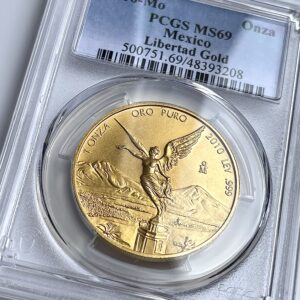
Mexico – 2010 – Libertad – Gold coin 1 oz – PCGS MS69
3.150,00 €plus shippingDelivery Time: approx. 2-3 days (excluding Saturdays, Sundays and public holidays) -
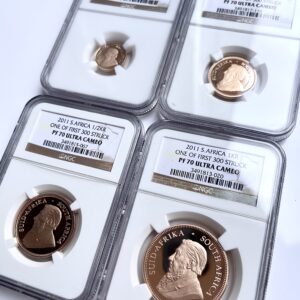
Krugerrand – 2011 – Set – One of First 300 – 4 Gold Coins Proof – NGC PF70 UCAM
5.500,00 €plus shippingDelivery Time: approx. 2-3 days (excluding Saturdays, Sundays and public holidays) -
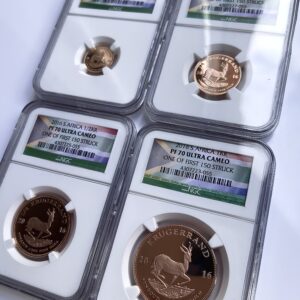
Krugerrand – 2016 – Set – One of First 150 – 4 Gold Coins Proof – NGC PF70 UCAM
5.500,00 €plus shippingDelivery Time: approx. 2-3 days (excluding Saturdays, Sundays and public holidays) -
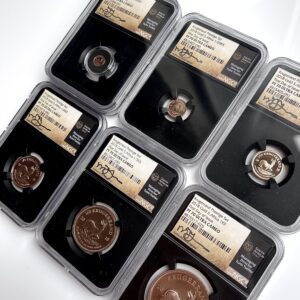
Krugerrand – 2018 – Set – First Day of Issue – 6 Gold Coins Proof – NGC PF70 UCAM
5.750,00 €plus shippingDelivery Time: approx. 2-3 days (excluding Saturdays, Sundays and public holidays) -
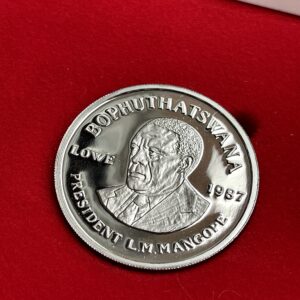
Bophuthatswana – 1987 – 10 years of independence – platinum – 1oz – with original case and certificate
2.195,00 €plus shippingDelivery Time: approx. 2-3 days (excluding Saturdays, Sundays and public holidays) -
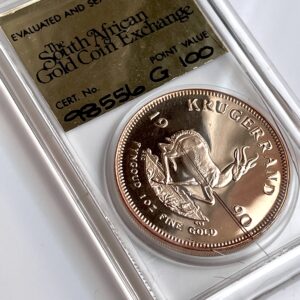
South Africa – Krugerrand – GRC – 1990 – SAGCE PoV 100 – 1oz Proof Gold
3.250,00 €plus shippingDelivery Time: approx. 2-3 days (excluding Saturdays, Sundays and public holidays) -
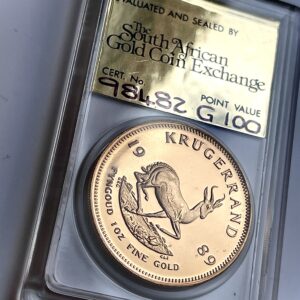
South Africa – Krugerrand – GRC – 1989 – SAGCE PoV 100 – 1oz Proof Gold
3.250,00 €plus shippingDelivery Time: approx. 2-3 days (excluding Saturdays, Sundays and public holidays) -
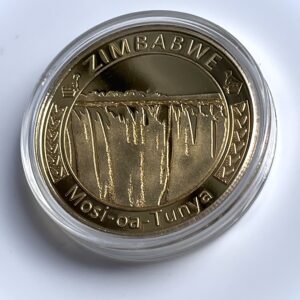
Zimbabwe – 2022 – Mosi-oa-Tunya – 1oz Proof Gold
3.150,00 €plus shippingDelivery Time: approx. 2-3 days (excluding Saturdays, Sundays and public holidays)

